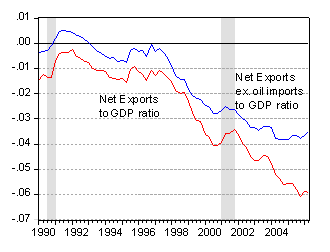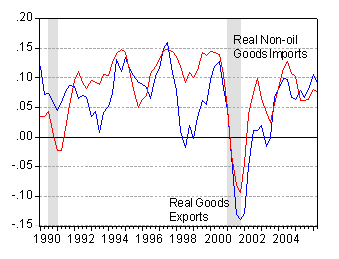Stabilization in the non-oil trade balance arrives. What needs to happen for adjustment to continue without a recession?
The preliminary NIPA figures for 2006q2 revealed that the non-oil trade balance (in nominal terms) has pretty convincincly stabilized as a share of GDP, while total net exports may have peaked. As mentioned earlier, the oil component is almost entirely driven by oil prices, rather than quantities, abstracting from supply shocks such as Katrina. (Unfortunately, oil prices have been about $2 per barrel higher in the first two months of q3 than in q2, so the oil component is likely to rise in this quarter despite the recent price drops, even if a disruption to Gulf oil production is avoided.)

Figure 1: Total goods and services net exports (red) and total net exports ex petroleum and petroleum products imports (blue), expressed as a ratio to GDP. Source: BEA NIPA August 30 release.
It is important to recall that this stabilization comes somewhat more delayed than what many had expected. Displayed in Figure 2 is the non-oil trade balance and the two year lagged dollar real exchange rate measured against a broad basket of currencies. In the previous adjustment episode during the mid-1980s, these two series matched almost exactly. In the current episode, the adjustment appears to lag by an extra year (of course, this is a very simple bilateral correlation; a more sophisticated analysis [pdf] would include US income and foreign income, as well as other factors).

Figure 2: Total net exports ex petroleum and petroleum products imports, expressed as a ratio to GDP (red line), and real dollar exchange rate against broad basket of currencies, (blue line). Source: BEA NIPA August 30 release and Federal Reserve System.
Interestingly, real (as opposed to nominal) goods exports have been growing (year-on-year) faster than real non-oil goods imports for the past year and half. But in the last quarter, both import and export growth rates have declined. So obviously further shrinkage in the trade deficit to GDP ratio is not guaranteed.

Figure 3: Year-on-year logarithmic change in real goods exports (blue) and real imports ex petroleum and petroleum products imports (red). Source: BEA NIPA August 30 release.
I think one point that has not been highlighted before (excepting Brad Setser) is the fact that continued adjustment has substantive implications for interpreting the prospects of growth. In order for real exports to continue to rise, and real imports to fall, it is likely some expenditure switching will need to occur — namely that consumption and investment expenditure need to decline. That is, the composition of GDP will need to change toward net exports, and away from domestic absorption. (Deutsche Bank’s worst case scenario for housing decline fits the bill — shaving 1.3 ppts off of baseline consumption growth in 2006H2, and 1.8 ppts off in 2007.)
Hence, it strikes me that predictions that consumption and domestic investment (which is very heavily composed of nontradables) presupposes that trade balance adjustment will not continue in a significant way. Unless, of course, there is renaissance in production of tradable goods and services.
Consequently, in the coming quarters, if indeed net exports pick up as the engine for demand growth, we might see some typical indicators (personal spending, residential and structures-related business investment, domestic goods orders) declining, while others (durables manufacturing output, exports) rising. Stressing the former set of indicators might result in misleading inferences. Of course, I don’t think such a divergence has happened before, so we’ll have to see if it happens this time. (In the mid-1980s, export growth accelerated while consumption and GDP growth held relatively steady — but that was against the backdrop of a much smaller trade deficit to GDP ratio. As Nouriel Roubini has pointed out, this scenario requires some “decoupling”)
Technorati Tags: trade deficits,
oil imports,
oil prices, recession,
and manufacturing
nothing much to add; very nice analysis
But is fighting more poverty ripping down more barriers and crossing more borders importing more of their dumped goods faster in our market place? As was it is. It is not. When bubbles are popping, there is a current account deficit.
The account deficit is meaningless. You give an IOU for their goods then the IOU is redeemed for your goods. So?